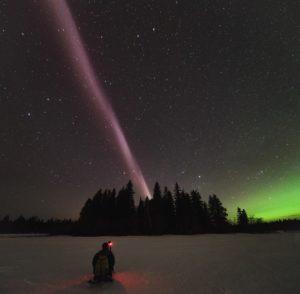7 April 2020
Scientists propose explanation for night sky glow of STEVE
Posted by Lauren Lipuma

Alberta Aurora Chasers capture STEVE on the evening of April 10, 2018 in Prince George, British Columbia, Canada. Robert Downie kneels in the foreground while photographer Ryan Sault captures the narrow ribbon of white-purple hues overhead. The vibrant green aurora is seen in the distant north, located to the right in the photo.
Credit: Ryan Sault.
By Lauren Lipuma
Researchers have just published a theory of what powers the celestial phenomenon known as STEVE, the aurora-like glow amateur sky-watchers brought to scientists’ attention in 2016.
The northern and southern lights, or aurora, typically show up as swirling green ribbons of light spreading across the night sky near the poles. But STEVE is a thin ribbon of mauve or white light that stretches from east to west, closer to the equator than where auroras usually appear and at much higher altitudes.
Scientists first thought STEVE was a new kind of aurora, but previous research shows its light is not produced the same way. Researchers are still unsure of what generates STEVE’s light, but a group of space physicists now suspect STEVE lights up when fast-flowing rivers of plasma jumpstart certain chemical reactions high in the atmosphere.
The theory is untested, but if it proves correct, it would mean there is a new mechanism for generating glowing lights in Earth’s upper atmosphere, according to the researchers.
“It’s just exciting for me to find something where, you could ask a very simple question about it, like, ‘What is this?’ And it turns out the answer to that question is very nuanced and exciting and may indicate some new physics,” said Brian Harding, a space physicist at the University of California Berkeley and lead author of a new study describing the theory in AGU’s journal Geophysical Research Letters.
A different kind of light
Earth’s magnetic field creates a cocoon around the planet called the magnetosphere. When charged particles streaming from the sun disturb Earth’s magnetosphere, some particles in the magnetosphere – mostly bare protons and electrons – rain down into the upper atmosphere. These charged particles excite oxygen and nitrogen gas in the atmosphere, which produces light of varying colors.
When scientists first began studying STEVE, they thought it was a kind of aurora. But a 2018 study found its glow is not due to charged particles raining down into Earth’s upper atmosphere, and researchers have been puzzling over what causes STEVE ever since.
The first scientific study published on STEVE found a stream of fast-moving plasma – a hot gas of charged particles and electrons – passing through the atmosphere right where STEVE events occurred. The researchers suspected these particles were connected to STEVE but were unsure whether they were the cause of it. These super-fast plasma flows stream through the upper atmosphere when the magnetosphere is disturbed, at about the speed it takes to orbit Earth, and STEVE occurs only during the fastest flows.
Harding and his colleagues suspect the fastest plasma rivers break chemical bonds in the upper atmosphere, triggering reactions that produce light. In the new study, Harding and his colleagues devised a theory to explain how this process could produce STEVE’s characteristic band of light and tested their idea with a simple simulation to see if the chemistry worked out.
Earth’s atmosphere is mostly made of nitrogen and oxygen gas: pairs of nitrogen and oxygen atoms bound together (N2 and O2). But in the upper atmosphere where STEVE occurs, oxygen molecules more easily break apart, and single atoms of oxygen are often found (O).
Harding and his team propose that when the streams of plasma are hot and fast enough, they can split apart nitrogen molecules (N2), which then combine with single oxygen atoms to form nitric oxide (NO). The nitric oxide then grabs another free oxygen atom to create nitrogen dioxide (NO2), a reaction that also produces light. The researchers suspect STEVE’s glow is the light from this chemical reaction, which makes sense because STEVE is found right where these plasma streams occur.
The researchers tested their theory with a simple simulation and found the idea is viable – in theory, the chemistry can explain the behavior of STEVE. The idea hasn’t been tested yet in the atmosphere, but Harding finds it an intriguing prospect.
“It would be more exciting if this were wrong, then we’re back at square one, and nature had confounded us again,” he said.
Lauren Lipuma is a science writer and multimedia producer at AGU.


 GeoSpace is a blog on Earth and space science, managed by AGU’s Public Information staff. The blog features posts by AGU writers and guest contributors on all sorts of relevant science topics, but with a focus on new research and geo and space sciences-related stories that are currently in the news.
GeoSpace is a blog on Earth and space science, managed by AGU’s Public Information staff. The blog features posts by AGU writers and guest contributors on all sorts of relevant science topics, but with a focus on new research and geo and space sciences-related stories that are currently in the news.
Scientist took note of this phenomenon called STEVE in just 2016. The fact are the two groups of citizen scientists reported the phenomenon now called STEVE to experts in this field twice between 2004 and 2012 One group was in the North Hemisphere and the other was in the Southern Hemisphere.Yep, both groups observations images and reports were blown off by the experts sadly.